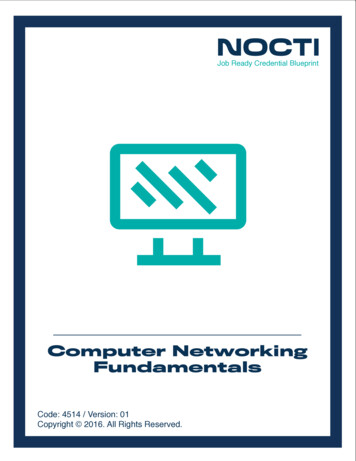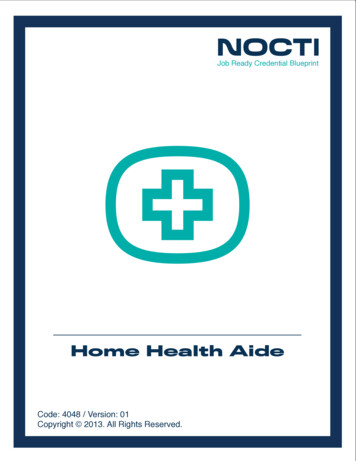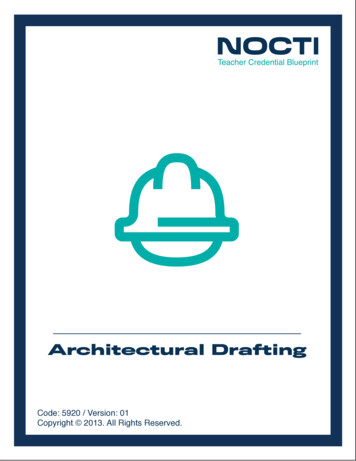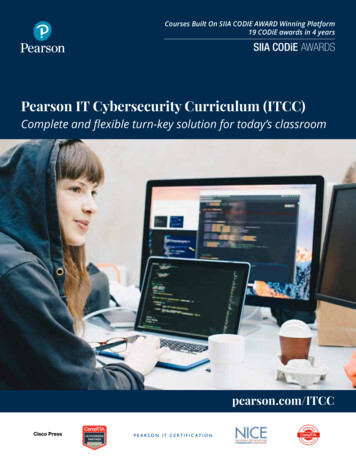
Transcription
Job Ready Credential BlueprintComputer NetworkingFundamentalsCode: 4514 / Version: 01Copyright 2016. All Rights Reserved.
Computer Networking FundamentalsGeneral Assessment InformationBlueprint ContentsGeneral Assessment InformationSample Written ItemsWritten Assessment InformationPerformance Assessment InformationSpecific Competencies Covered in the Test Sample Performance JobTest Type: The Computer Networking Fundamentals industry-based credential isincluded in NOCTI’s Job Ready assessment battery. Job Ready assessments measuretechnical skills at the occupational level and include items which gauge factual andtheoretical knowledge. Job Ready assessments typically offer both a written andperformance component and can be used at the secondary and post-secondary levels.Job Ready assessments can be delivered in an online or paper/pencil format.Revision Team: The assessment content is based on input from secondary,post-secondary, and business/industry representatives from the states of Georgia, NewYork, Oklahoma, and Pennsylvania.CIPCode11.0901- Computer SystemsNetworking andTelecommunicationsCareer Cluster 11Information Technology15-1151.00Computer UserSupport SpecialistsThe Association for Career and Technical Education (ACTE), the leading professionalorganization for career and technical educators, commends all students whoparticipate in career and technical education programs and choose to validate theireducational attainment through rigorous technical assessments. In taking thisassessment you demonstrate to your school, your parents and guardians, your futureemployers and yourself that you understand the concepts and knowledge needed tosucceed in the workplace. Good Luck!In the lower divisionbaccalaureate/associate degreecategory, 3 semester hours inComputer NetworkingFundamentals, Computer Science,or Computer Information Systems.NOCTI Job Ready AssessmentPage 2 of 10
Computer Networking FundamentalsWritten AssessmentNOCTI written assessments consist of questions to measure an individual’s factualtheoretical knowledge.Administration Time: 3 hoursNumber of Questions: 194Number of Sessions: This assessment may be administered in one, two, or three sessions.Areas Covered10%6%7%11%10%12%6%5%12%11%10%NOCTI Job Ready AssessmentPage 3 of 10
Computer Networking FundamentalsSpecific Standards and Competencies Included in this AssessmentPC Principles Identify physical and equipment safety and maintenance principles and practices Demonstrate understanding of storage methods (e.g., external, network attached,cloud) Exhibit understanding of memory Demonstrate uses of eSATA, Bluetooth , and USB Identify different types and standards of processors Develop an understanding of various client operating systemsNetwork Connections Demonstrate understanding of Network Interface Cards (NICs) Identify different physical and logical characteristics of network connections Demonstrate use of remote access (e.g., Windows terminal services, terminalemulation software, VPN, telephone connections, SSH) Exhibit understanding of wired and wireless communications and standardsPhysical Connection Types Identify cable components and uses, including twisted pair and fiber Demonstrate understanding of signal characteristics and transmission amongvarious media typesNetwork Standards and Devices Demonstrate understanding of OSI model layers Demonstrate familiarity with TCP/IP model Identify IEEE, EIA/TIA standards and common Port numbers Distinguish various types and uses of wired network devices Distinguish various types and uses of wireless network devices(Continued on the following page)NOCTI Job Ready AssessmentPage 4 of 10
Computer Networking FundamentalsSpecific Standards and Competencies (continued)Network Troubleshooting Utilize ping, ipconfig, tracert, and netstat commands Maintain and troubleshoot cabling Perform local and remote loopback Identify various troubleshooting methodologies (e.g., top-down, bottom-up,divide and conquer) Utilize, perform, and analyze a packet captureRouting and Switching Explain the difference between static, dynamic, default, and gateway routes Demonstrate an understanding of WAN connection types Recognize and implement basic router operations and configurations Demonstrate understanding of switch operations and configurations (e.g., VLAN,interVLAN) Compare and contrast routed vs. routing protocols Differentiate between a collision domain and a broadcast domainNetwork Terminology Demonstrate familiarity with various protocols and architecture terminology Demonstrate familiarity with DHCP and DNS Identify various network operating systems (e.g., Windows , Linux ) Identify various network typesNetwork Architecture Exhibit understanding of physical and logical networking topologies (e.g., access,core, distribution) Exhibit understanding of various LAN, MAN, PAN, WLAN, and WAN topologies(Continued on the following page)NOCTI Job Ready AssessmentPage 5 of 10
Computer Networking FundamentalsSpecific Standards and Competencies (continued)Network Addressing Exhibit knowledge of IP network addressing (e.g., IPv4, IPv6) Differentiate between classful and classless IP addressing Demonstrate understanding of Media Access Control (MAC) addressing Convert binary, hexadecimal, and decimal numbering systems Create subnets from a network addressSecurity Identify and troubleshoot basic organizational and acceptable use policies Implement and maintain device security procedures Explain the defense in-depth approach to security (e.g., DMZ, Bastion Host) Identify and troubleshoot network security attacks and breaches Identify and troubleshoot viruses, worms, and other forms of malware Install and maintain appropriate firewalls, including NAT Explain general cryptography conceptsNetwork Planning and Design Exhibit understanding of analysis and planning concepts Compare and contrast principles of logical and physical design Identify various forms of power protection, backups, and UPS Explain the appropriate use and benefits of thin clients Install, maintain, and troubleshoot physical and wireless networks according todesign specifications Describe various access methods (e.g., ISP, DSL, broadband/cable, satellite,wireless, mobile) Explain the principles of virtualizationNOCTI Job Ready AssessmentPage 6 of 10
Computer Networking FundamentalsSample QuestionsUse to achieve transfer rates much higher than those of USB 2.0 FireWire 400.A. ATAB. SATA 150C. eSATAD. FlashEthernet uses to ensure packet delivery.A. token passingB. multicastingC. collision detectionD. broadcastingPerforming a loopback test on a router will check the first.A. LAN routing tablesB. total number of packets lostC. WAN interface operabilityD. IP address of the LAN interfaceThe purpose of the Domain Name Service (DNS) is toA. supply valid IP addresses as requested by network hostsB. centrally manage the mapping of host names to IP addressesC. authenticate IP addresses before passing data packets to other network devicesD. facilitate dynamic addressingThe NIC is installed onA. the system boardB. a port in the modemC. the CPUD. a CD-ROM drive(Continued on the following page)NOCTI Job Ready AssessmentPage 7 of 10
Computer Networking FundamentalsSample Questions (continued)User IDs, passwords, and access rights are all considered part ofA. physical securityB. personal informationC. login requirementsD. logical securityThe data-link layer uses to organize, or group, bits of data.A. framesB. packetsC. headersD. trailersA common interior routing protocol isA. BGPB. UDPC. RIPD. VPNWhich best describes a hybrid topology?A. starB. busC. extended starD. star-wired ringThe purpose of a surge protector is to protect computer equipment fromA. sagsB. blackoutsC. brownoutsD. spikesNOCTI Job Ready AssessmentPage 8 of 10
Computer Networking FundamentalsPerformance AssessmentNOCTI performance assessments allow individuals to demonstrate their acquired skills bycompleting actual jobs using the tools, materials, machines, and equipment related to thetechnical area.Administration Time: 2 hoursNumber of Jobs: 2Areas Covered:39%39% Select and Connect Equipment to Set Up a61%Simple LAN with Two WorkstationsParticipant will select appropriate equipment, assigna private Class C address and subnet, record the results,verify IP connectivity, verify that the network was created, andleave the IP connectivity results on screen for evaluator review.61% Set Up a Workgroup, Create Users, Create Shares and Install a PrinterParticipant will name the workstations, make each workstation a member of workgroupnamed NOCTI, create users, create folders/directories, create a share, grant controlpermission to folders/directories, attempt to access folders/directories, install printer,assign printer rights, and verify correct set-up/functionality.NOCTI Job Ready AssessmentPage 9 of 10
Computer Networking FundamentalsSample JobWireless ConfigurationMaximum Time: 1 hourParticipant Activity: Participant will name the workstations, make each workstation amember of workgroup named NOCTI, create two users, create two folders/directories,create a share, grant full control permission to folders/directories, log in and attempt toaccess folders/directories, install printer, assign printer rights, verify correctset-up/functionality and notify evaluator when finished.NOCTI Job Ready AssessmentPage 10 of 10
Test Type: The Computer Networking Fundamentals industry-based credential is included in NOCTI's Job Ready assessment battery. Job Ready assessments measure technical skills at the occupational level and include items which gauge factual and theoretical knowledge. Job Ready assessments typically o er both a written and










